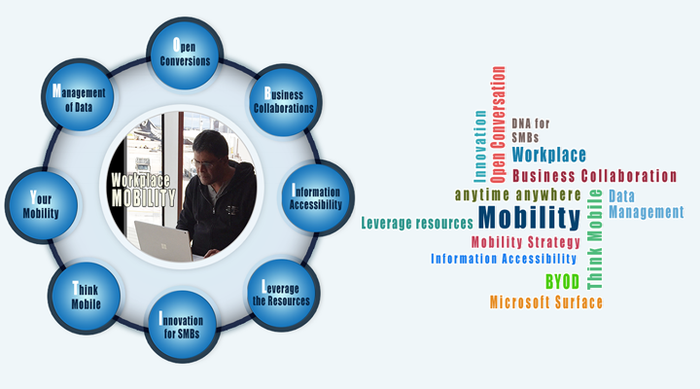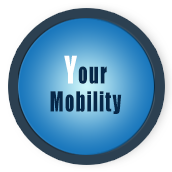
Modern workplace has changed in ways we never envisioned before. Today, it’s okay to work in your pyjamas and more than okay to work from anywhere you want — be it your local coffee shop, or a beach in Bali, or simply from the comfort of your home. Office is no longer within four walls, it’s where you are! Work-forces across world, including here in [bctt tweet=”Australia, are willing to kick their 9-to-5 jobs to the curb and warming up to the whole new way of “anytime, anywhere” work”].

Mobile technology is one of the biggest forces driving these changes and it has — and continues to — revolutionise the workplace environment by supporting new concepts like BYOD, remote working, and virtual workplace. With the nature of workplace transforming across industries at such a rapid pace, organisations need to change the way they operate and manage their workforces.
Change is Here and There’s No Way to Escape it
Mobility is affecting companies and workplaces in a number of ways, which also includes recruitment and retention of talent. Employees are demanding greater workplace flexibility to stay productive and to achieve a decent work-life balance. To recruit and retain top talents, more employers are willing to prioritise workplace mobility.
I have been personally practicing this concept for more than 5 years and if you ask me from my personal experience, [bctt tweet=”mobility is a big part of (and even enabler of) the digital culture SMBs need to — but are failing to — adopt.”] Therefore, if you still think you can get away by sticking to conventional hierarchies and workplace regulations while running your SMB, think again! For SMBs, the ability to attract and nurture a steady talent pool can have far-reaching ramifications on the entire organisation.
A study from last year shows that 84% of organisations in Australia, like my company solomoIT have some staff who regularly perform their job outside a remote location. With Australian businesses becoming more global, distributed teams — perfect for conducting customer service across time-zones and in many languages — are soon going to become a norm. A case in point is Envato, a Melbourne-based startup that introduced a work-from-anywhere policy, not only to support its growing global foothold but also to compete with foreign companies for the best Australian talents.
Whether you like it or not, [bctt tweet=”mobility is a race you’ll either enter willingly or will be forced to enter eventually. Is your SMB prepared for the change?”]
So, in my normal style, let me use the word ‘MOBILITY’ as an acronym to discuss eight ways SMBs can reap the benefits of workplace mobility trends.

 MANAGEMENT of data is crucial
MANAGEMENT of data is crucial
New devices and tech solutions are constantly making way into the workplace. From smartphones and tablets to wearables and other hybrid productivity devices like Microsoft Surface— employees are getting increasingly dependent on these devices to work better and more productively.
The entry of mobile devices in the workplace is giving rise to challenges in terms of how SMBs are managing the opening up of their corporate data network. The practice of BYOD, for instance, is fraught with several security issues if appropriate policies regarding data management and regulations are not put in place.
A survey by Citrix revealed nearly 65% of companies that witness personal device usage for work purposes don’t have a policy, procedure or IT system in place to manage employees’ personal devices. This could be an easy way for your confidential company data to leak out if a device is lost or stolen.
 OPEN conversations and well-defined policies are a must
OPEN conversations and well-defined policies are a must
The drive for mobile work policies is being led, more than ever, by employees looking to work productively while improving their work/life balance. It’s no longer the road warriors, such as the sales teams, that are demanding remote work facilities mobility can afford. Today, employees across every discipline recognise the benefits mobility can bring to both their professional and personal lives.
Encouraging open dialogue is important to understand and secure support, while also educating and training employees to use their devices responsibly. Right from employee role, working hours, department to device type, security requirements, and networks, etc. — everything needs to be considered thoroughly before taking the BYOD route. Clearly spelled out policies are critical in identifying and eliminating any inconsistencies in the way employees are practising BYOD.
 BUSINESS collaboration has changed forever
BUSINESS collaboration has changed forever
In today’s knowledge-based economy, businesses are becoming aware of the fact that collaboration technologies are not just about effective meetings. With text, video calls, and [bctt tweet=”unified communications sharing space with emails and phone calls, the face of business collaboration has changed and how!”]
In fact, it’s no longer about being able to connect with colleagues and clients for work-related tasks. The real [bctt tweet=”value of collaboration lies in enabling greater creativity and innovation, by allowing those inside and outside the company to work”] together, serving customers, creating value, and improving the quality of life.
 INFORMATION is more accessible
INFORMATION is more accessible
Thanks to the rapid growth in smart technologies, driven by the consumerisation of IT, most people rely on devices besides their PC or desktop. The Citrix survey found that as many as 65% people used their smartphones or laptops or now the hybrid devices like Microsoft Surface as opposed to 58% who still primarily used a PC or desktop computer.
This increasingly mobile environment not only allows faster and more efficient work outcomes but also enables your employees to have crucial information at their fingertips, irrespective of their location. Making available the right tools and technologies, therefore, will play a major role in your company’s success both, as an employer and a service provider.
Hybrid devices like Microsoft Surface offer a great way for SMBs to embark on a mobility journey at cost-effective price points.” As the forces of digitalisation reshape the business landscape, SMBs will need to adopt these new technologies to adapt and sustain.
 LEVERAGE the resources in real time
LEVERAGE the resources in real time
Access to [bctt tweet=”real-time data is a big differentiator in many business, considering how the ability to manage and analyse data can turn the tide”] in today’s business landscape. This is why introducing applications and tools that equip employees with real-time data can revolutionise conventional ways of working and create enormous impacts on customer loyalty, profits and sales.
An interesting example of this is AirBnB. Last year, the home-sharing brand launched AirPal, an open-source tool that allows its employees an access to the company’s 1.5 petabytes of data using a simple search.
Providing employees with real-time data on everything from the number of people staying at a certain AirBnB location to the amount of listings in a neighbourhood, the tool aims to eliminate the technology roadblocks that prevented faster resolution of customer queries in the past. Plus, this is also a great lesson in how trust and transparency are replacing old fashioned hierarchies and organisational silos by ensuring that every employee has access to deep customer insights every day. No wonder, AirBnB has been topping many charts as a company with ideal workplace environment.
 INNOVATION is the new DNA for SMBs
INNOVATION is the new DNA for SMBs
Today when everything right from business trends and technologies move at a lightening pace, early adopters are better positioned to control the course of their businesses than those that hang on to the rules of yesteryears until it’s too late. Honestly, innovation is the lifeblood of modern businesses.
[bctt tweet=”Mobility, with its power to change the workplace beyond recognition, is driving businesses to re-think”], re-align, and rewire their operations, goals, and overall views. On the other hand, the typical we’ve-always-done-it-this-way attitude is nothing but cancerous to growth and success. THINK beyond mobile
THINK beyond mobile
Businesses have long discussed the subject of mobility from a device-focused perspective. Marketers build business cases using stats that talk about the growing smartphone market, the increasing numbers of mobile users, number of people downloading mobile apps, and so on. But that’s really the device part of the story. I mean mobile, in itself, is just a device like its predecessors—mainframes, PCs, and desktops.
It’s the other half of the story—the experiences and benefits it provides to the users—that’s more important. For instance, a mobile device is one that allows you to untether from the office, but it’s the experience of untethering that creates value in the form of enhanced productivity and better remote operations. Therefore, when it comes to what most businesses are seeking to achieve with mobile, it’s important to think in terms of value — to your business, your employees, and your customers.
 YOUR Mobility strategies should be in one place
YOUR Mobility strategies should be in one place
With trends like globalisation and 24/7 [bctt tweet=”connectivity forcing the box to be enlarged or perhaps reinvented altogether, businesses need to take a “cultural” leap into mobility.”] I say “cultural” because it really calls for a change not just on operational level but much deeper — on a mindset-level.
Therefore, in order to truly win at mobility, you need mobility to reflect across all your business strategies, operations, and conversations to create a seamless omni-channel experience for your employees and customers, alike. Simply revamping workplace rules won’t do. You need to apply a well-rounded mobility strategy to everything including your marketing and advertising efforts across all mediums and channels — print, online, video, search, social, out-of-home, and website.
Summing it up
As mobility adoption continues to surge in the business world, it’s becoming critical for SMBs to throw their hats into the mobility arena — not only to compete neck-to-neck with larger enterprises but also to retain control, maintain security, and keep employees happy and productive without incurring additional costs. Here’s a quick recap of mobility management tips we’ve discussed so far that will help you get started in the right direction:
- Make data management a priority
- Have open dialogues and clear policies
- Explore new ways of business collaboration
- Get the right tools to encourage productive use of information
- Make real-time data more accessible
- Innovate to grow
- Instead of the device, think of the value it creates
- Build an all-encompassing mobility strategy
Want to transform your business digitally but not sure how to go about it? Feel free to contact me for an in-house session or virtual consulting to help you get started!
